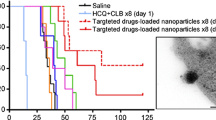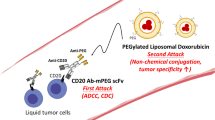Abstract
A new drug-free nanotherapeutic approach for B-cell malignancies was developed. Exposure of B-cells to an anti-CD20 Fab’-morpholino oligonucleotide1 (MORF1) conjugate decorated the cell surface with MORF1; further exposure of the decorated cells to multivalent polymer-oligonucleotide2 conjugates (P-MORF2) resulted in CD20 clustering at the cell surface with induction of apoptosis. We evaluated this concept in chronic lymphocytic leukemia (CLL) cells isolated from ten patients. Apoptosis and cytotoxicity were observed in eight samples, including two samples with the 17p13 deletion, which suggested a p53-independent mechanism of apoptosis induction. When compared to an anti-CD20 monoclonal antibody (mAb), the nanotherapeutic showed significantly more potent apoptosis-inducing activity and cytotoxicity. This was due to the multivalency effect (eight binding sites per polymer chain) of our design in comparison to the divalent mAb. In conclusion, we have developed a novel and potent therapeutic system against CLL and other B-cell malignancies with significant advantages over conventional chemoimmunotherapy.


Similar content being viewed by others
References
Siegel R, Ma J, Zou Z, Jemal A. Cancer statistics 2014. CA Cancer J Clin. 2014;64:9–29.
Hofmeister JK, Cooney D, Coggeshall KM. Clustered CD20 induced apoptosis: src-family kinase, the proximal regulator of tyrosine phosphorylation, calcium influx, and caspase 3-dependent apoptosis. Blood Cells Mol Dis. 2000;26:133–43.
Zhang N, Khawli LA, Hu P, Epstein AL. Generation of rituximab polymer may cause hyper-cross-linking-induced apoptosis in non-Hodgkin’s lymphomas. Clin Cancer Res. 2005;11:5971–80.
Chu T-W, Yang J, Kopeček J. Anti-CD20 multivalent HPMA copolymer-Fab’ conjugates for the direct induction of apoptosis. Biomaterials. 2012;33:7174–81.
Chu T-W, Yang J, Zhang R, Sima M, Kopeček J. Cell surface self-assembly of hybrid nanoconjugates via oligonucleotide hybridization induces apoptosis. ACS Nano. 2014;8:719–30.
Press OW, Appelbaum F, Ledbetter JA, et al. Monoclonal antibody 1F5 (anti-CD20) serotherapy of human B cell lymphomas. Blood. 1987;69:584–91.
Byrd JC, Jones JJ, Woyach JA, Johnson AJ, Flynn JM. Entering the era of targeted therapy for chronic lymphocytic leukemia: Impact on the practicing clinician. J Clin Oncol. 2014;32:3039–47.
van der Kolk LE, Evers LM, Omene C, et al. CD20-induced B cell death can bypass mitochondria and caspase activation. Leukemia. 2002;16:1735–44.
Shan D, Ledbetter JA, Press OW. Apoptosis of malignant human B cells by ligation of CD20 with monoclonal antibodies. Blood. 1998;91:1644–52.
Johnson RN, Kopečková P, Kopeček J. Synthesis and evaluation of multivalent branched HPMA copolymer − Fab′ conjugates targeted to the B-cell antigen CD20. Bioconjug Chem. 2009;20:129–37.
Johnson RN, Kopečková P, Kopeček J. Biological activity of anti-CD20 multivalent HPMA copolymer − Fab’ conjugates. Biomacromolecules. 2012;13:727–35.
Aluri SR, Shi P, Gustafson JA, et al. A hybrid protein-polymer nanoworm potentiates apoptosis better than a monoclonal antibody. ACS Nano. 2014;8:2064–76.
Zhang Z, Eckert MA, Ali MM, et al. DNA-scaffolded multivalent ligands to modulate cell function. ChemBioChem. 2014;15:1268–73.
Pan H, Yang J, Kopečková P, Kopeček J. Backbone degradable multiblock N-(2-hydroxypropyl)methacrylamide copolymer conjugates via reversible addition-fragmentation chain transfer polymerization and thiol-ene coupling reaction. Biomacromolecules. 2011;12:247–52.
Yang J, Luo K, Pan H, Kopečková P, Kopeček J. Synthesis of biodegradable multiblock copolymers by click coupling of RAFT-generated heterotelechelic polyHPMA conjugates. React Funct Polym. 2011;71:294–302.
Zhang R, Yang J, Sima M, Zhou Y, Kopeček J. Sequential combination therapy of ovarian cancer with degradable N-(2-hydroxypropyl)methacrylamide copolymer paclitaxel and gemcitabine conjugates. Proc Natl Acad Sci U S A. 2014;111:12181–6.
Danilov AV. Targeted therapy in chronic lymphocytic leukemia: Past, present, and future. Clin Ther. 2013;35:1258–70.
Goodwin DA, Meares CF. Advances in pretargeting biotechnology. Biotechnol Adv. 2001;19:435–50.
Gunn J, Park SI, Veiseh O, Press OW, Zhang M. A pretargeted nanoparticle system for tumor cell labeling. Mol Biosyst. 2011;7:742–8.
Acknowledgments
This work was supported in part by NIH grant GM95606 (to J.K.) from the National Institute of General Medical Sciences and the University of Utah Research Foundation. The authors thank Dr. Ruozhen Hu for assisting with cell cycle analysis and Dr. Jiyuan Yang and Dr. Rui Zhang for helpful discussions.
Conflict of interest
J.K. and T.-W.C. are inventors on a pending US patent application (PCT/US2014/023784; assigned to the University of Utah) related to this work. J.K. is Chief Scientific Advisor and P.J.S. Chief Medical Advisor for Bastion Biologics. Otherwise, the authors declare no relevant financial interests.
Informed consent
All procedures followed were in accordance with the ethical standards of the responsible committee on human experimentation (institutional and national) and with the Helsinki Declaration of 1975, as revised in 2000. Informed consent was obtained from all patients for being included in the study.
Author information
Authors and Affiliations
Corresponding author
Rights and permissions
About this article
Cite this article
Chu, TW., Kosak, K.M., Shami, P.J. et al. Drug-free macromolecular therapeutics induce apoptosis of patient chronic lymphocytic leukemia cells. Drug Deliv. and Transl. Res. 4, 389–394 (2014). https://doi.org/10.1007/s13346-014-0209-8
Published:
Issue Date:
DOI: https://doi.org/10.1007/s13346-014-0209-8




